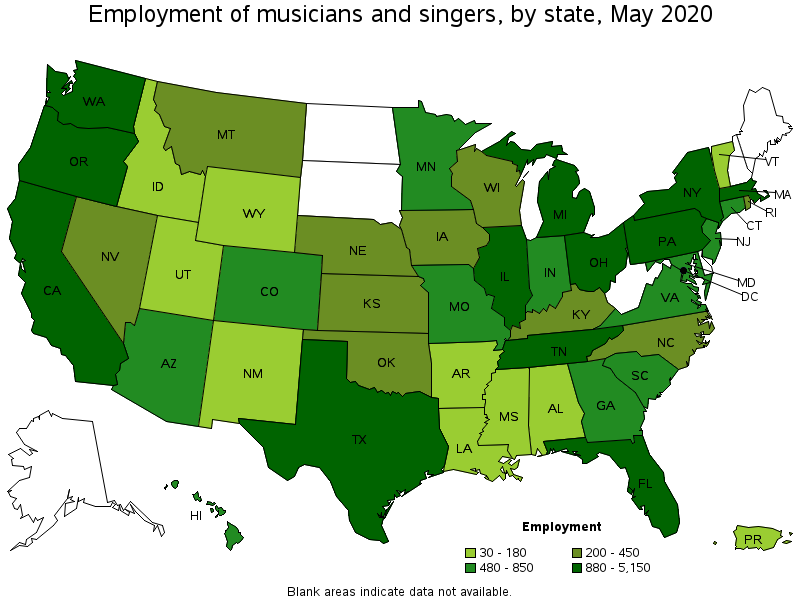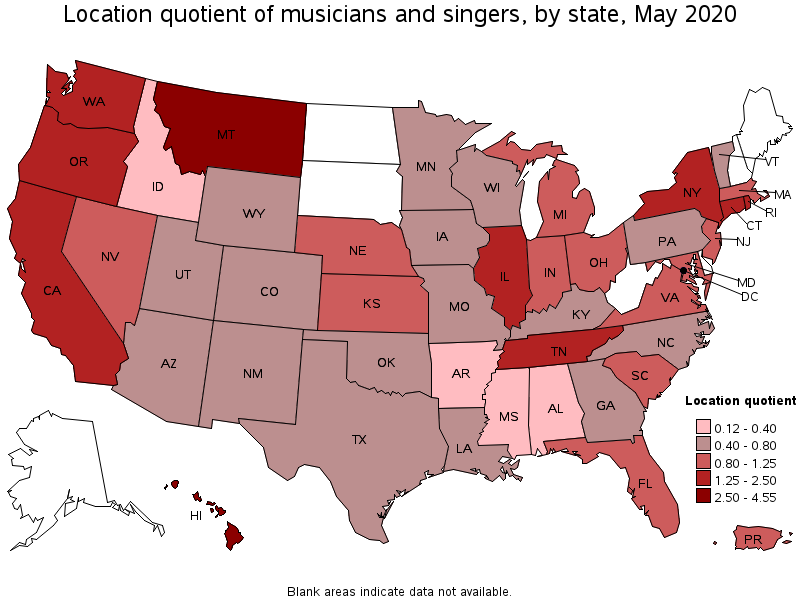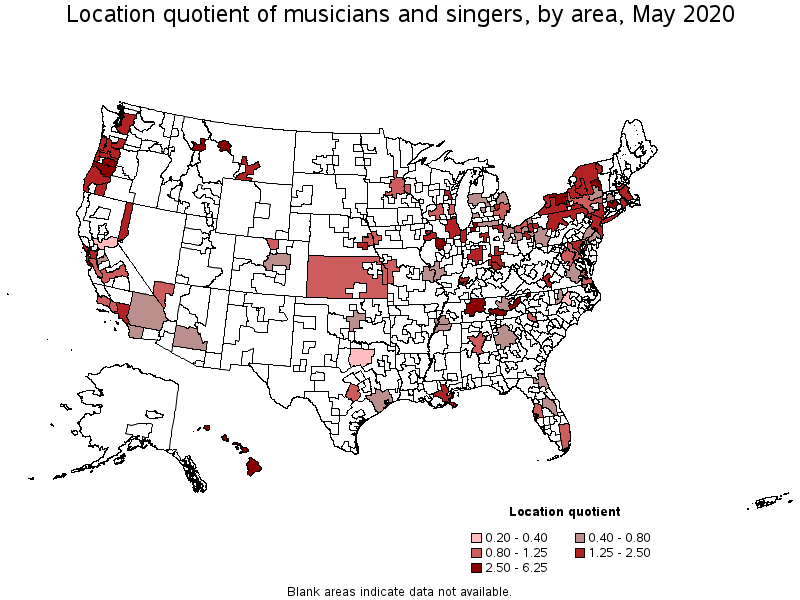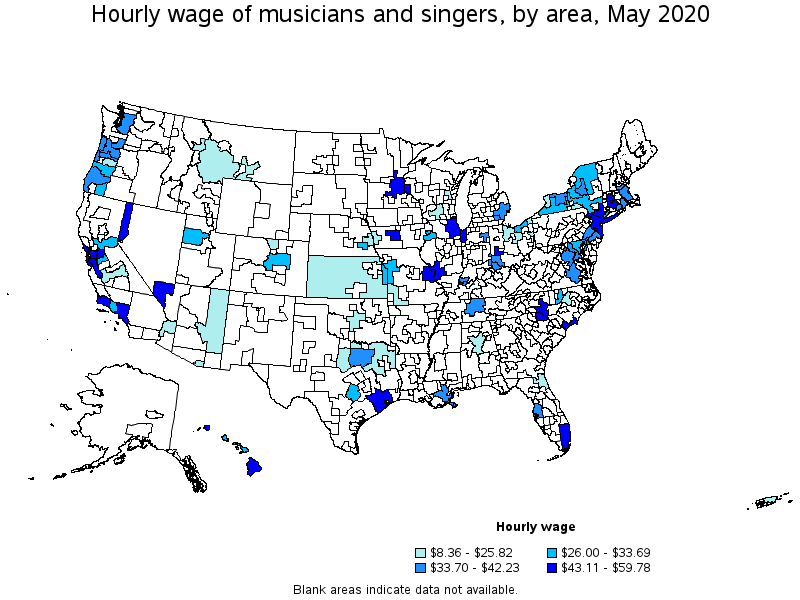An official website of the United States government
 United States Department of Labor
United States Department of Labor
Play one or more musical instruments or sing. May perform on stage, for broadcasting, or for sound or video recording.
Employment estimate and mean wage estimates for Musicians and Singers:
| Employment (1) | Employment RSE (3) |
Mean hourly wage |
Mean annual wage (2) |
Wage RSE (3) |
|---|---|---|---|---|
| 34,770 | 3.6 % | $ 41.72 | (4) | 2.5 % |
Percentile wage estimates for Musicians and Singers:
| Percentile | 10% | 25% | 50% (Median) |
75% | 90% |
|---|---|---|---|---|---|
| Hourly Wage | $ 11.17 | $ 17.67 | $ 31.40 | $ 54.60 | $ 87.47 |
Industries with the highest published employment and wages for Musicians and Singers are provided. For a list of all industries with employment in Musicians and Singers, see the Create Customized Tables function.
Industries with the highest levels of employment in Musicians and Singers:
| Industry | Employment (1) | Percent of industry employment | Hourly mean wage | Annual mean wage (2) |
|---|---|---|---|---|
| Performing Arts Companies | 15,960 | 15.61 | $ 48.47 | (4) |
| Religious Organizations | 8,670 | 4.62 | $ 38.27 | (4) |
| Elementary and Secondary Schools | 2,230 | 0.03 | $ 29.77 | (4) |
| Colleges, Universities, and Professional Schools | 1,760 | 0.06 | $ 29.95 | (4) |
| Independent Artists, Writers, and Performers | 1,550 | 3.21 | $ 35.27 | (4) |
Industries with the highest concentration of employment in Musicians and Singers:
| Industry | Employment (1) | Percent of industry employment | Hourly mean wage | Annual mean wage (2) |
|---|---|---|---|---|
| Performing Arts Companies | 15,960 | 15.61 | $ 48.47 | (4) |
| Religious Organizations | 8,670 | 4.62 | $ 38.27 | (4) |
| Independent Artists, Writers, and Performers | 1,550 | 3.21 | $ 35.27 | (4) |
| Sound Recording Industries | 460 | 2.57 | (8) | (8) |
| Promoters of Performing Arts, Sports, and Similar Events | 930 | 0.81 | $ 50.74 | (4) |
Top paying industries for Musicians and Singers:
| Industry | Employment (1) | Percent of industry employment | Hourly mean wage | Annual mean wage (2) |
|---|---|---|---|---|
| Promoters of Performing Arts, Sports, and Similar Events | 930 | 0.81 | $ 50.74 | (4) |
| Death Care Services | 80 | 0.06 | $ 49.09 | (4) |
| Performing Arts Companies | 15,960 | 15.61 | $ 48.47 | (4) |
| Individual and Family Services | (8) | (8) | $ 45.91 | (4) |
| Religious Organizations | 8,670 | 4.62 | $ 38.27 | (4) |
States and areas with the highest published employment, location quotients, and wages for Musicians and Singers are provided. For a list of all areas with employment in Musicians and Singers, see the Create Customized Tables function.

States with the highest employment level in Musicians and Singers:
| State | Employment (1) | Employment per thousand jobs | Location quotient (9) | Hourly mean wage | Annual mean wage (2) |
|---|---|---|---|---|---|
| California | 5,150 | 0.31 | 1.25 | $ 49.07 | (4) |
| New York | 5,110 | 0.59 | 2.35 | $ 45.59 | (4) |
| Illinois | 1,940 | 0.34 | 1.38 | $ 49.24 | (4) |
| Florida | 1,690 | 0.20 | 0.80 | $ 43.14 | (4) |
| Tennessee | 1,590 | 0.55 | 2.19 | $ 34.59 | (4) |

States with the highest concentration of jobs and location quotients in Musicians and Singers:
| State | Employment (1) | Employment per thousand jobs | Location quotient (9) | Hourly mean wage | Annual mean wage (2) |
|---|---|---|---|---|---|
| Hawaii | 650 | 1.14 | 4.55 | $ 35.74 | (4) |
| Montana | 300 | 0.65 | 2.59 | $ 14.20 | (4) |
| New York | 5,110 | 0.59 | 2.35 | $ 45.59 | (4) |
| Tennessee | 1,590 | 0.55 | 2.19 | $ 34.59 | (4) |
| Oregon | 900 | 0.50 | 2.00 | $ 32.95 | (4) |

Top paying states for Musicians and Singers:
| State | Employment (1) | Employment per thousand jobs | Location quotient (9) | Hourly mean wage | Annual mean wage (2) |
|---|---|---|---|---|---|
| Georgia | 570 | 0.13 | 0.53 | $ 67.02 | (4) |
| Indiana | 700 | 0.24 | 0.96 | $ 52.77 | (4) |
| Arizona | 540 | 0.19 | 0.77 | $ 51.78 | (4) |
| Nevada | 300 | 0.24 | 0.96 | $ 50.87 | (4) |
| Illinois | 1,940 | 0.34 | 1.38 | $ 49.24 | (4) |

Metropolitan areas with the highest employment level in Musicians and Singers:
| Metropolitan area | Employment (1) | Employment per thousand jobs | Location quotient (9) | Hourly mean wage | Annual mean wage (2) |
|---|---|---|---|---|---|
| New York-Newark-Jersey City, NY-NJ-PA | 4,520 | 0.51 | 2.05 | $ 48.66 | (4) |
| Los Angeles-Long Beach-Anaheim, CA | 2,880 | 0.49 | 1.98 | $ 49.11 | (4) |
| Chicago-Naperville-Elgin, IL-IN-WI | 1,590 | 0.37 | 1.46 | $ 48.70 | (4) |
| Nashville-Davidson--Murfreesboro--Franklin, TN | 1,230 | 1.27 | 5.09 | $ 36.24 | (4) |
| Seattle-Tacoma-Bellevue, WA | 1,040 | 0.53 | 2.12 | $ 36.30 | (4) |
| Washington-Arlington-Alexandria, DC-VA-MD-WV | 890 | 0.30 | 1.18 | $ 42.16 | (4) |
| San Francisco-Oakland-Hayward, CA | 870 | 0.37 | 1.49 | $ 53.48 | (4) |
| Boston-Cambridge-Nashua, MA-NH | 820 | 0.32 | 1.26 | $ 41.71 | (4) |
| Miami-Fort Lauderdale-West Palm Beach, FL | 550 | 0.22 | 0.88 | $ 46.88 | (4) |
| Philadelphia-Camden-Wilmington, PA-NJ-DE-MD | 470 | 0.18 | 0.70 | $ 33.83 | (4) |

Metropolitan areas with the highest concentration of jobs and location quotients in Musicians and Singers:
| Metropolitan area | Employment (1) | Employment per thousand jobs | Location quotient (9) | Hourly mean wage | Annual mean wage (2) |
|---|---|---|---|---|---|
| Albany, OR | 70 | 1.56 | 6.25 | $ 16.47 | (4) |
| Eugene, OR | 210 | 1.41 | 5.62 | $ 28.43 | (4) |
| Kahului-Wailuku-Lahaina, HI | 90 | 1.39 | 5.57 | $ 33.19 | (4) |
| Great Falls, MT | 40 | 1.30 | 5.22 | (8) | (8) |
| Nashville-Davidson--Murfreesboro--Franklin, TN | 1,230 | 1.27 | 5.09 | $ 36.24 | (4) |
| Missoula, MT | 60 | 1.07 | 4.26 | $ 10.03 | (4) |
| Urban Honolulu, HI | 440 | 1.05 | 4.20 | $ 33.69 | (4) |
| South Bend-Mishawaka, IN-MI | 120 | 0.93 | 3.71 | (8) | (8) |
| Peoria, IL | 140 | 0.87 | 3.47 | (8) | (8) |
| Trenton, NJ | 190 | 0.82 | 3.28 | $ 59.78 | (4) |

Top paying metropolitan areas for Musicians and Singers:
| Metropolitan area | Employment (1) | Employment per thousand jobs | Location quotient (9) | Hourly mean wage | Annual mean wage (2) |
|---|---|---|---|---|---|
| Trenton, NJ | 190 | 0.82 | 3.28 | $ 59.78 | (4) |
| Myrtle Beach-Conway-North Myrtle Beach, SC-NC | (8) | (8) | (8) | $ 56.77 | (4) |
| Charlotte-Concord-Gastonia, NC-SC | (8) | (8) | (8) | $ 54.89 | (4) |
| San Jose-Sunnyvale-Santa Clara, CA | 290 | 0.27 | 1.07 | $ 54.28 | (4) |
| San Francisco-Oakland-Hayward, CA | 870 | 0.37 | 1.49 | $ 53.48 | (4) |
| Las Vegas-Henderson-Paradise, NV | 200 | 0.22 | 0.89 | $ 52.95 | (4) |
| Des Moines-West Des Moines, IA | (8) | (8) | (8) | $ 51.51 | (4) |
| Dayton, OH | 130 | 0.35 | 1.40 | $ 51.10 | (4) |
| Minneapolis-St. Paul-Bloomington, MN-WI | 380 | 0.21 | 0.83 | $ 50.24 | (4) |
| Los Angeles-Long Beach-Anaheim, CA | 2,880 | 0.49 | 1.98 | $ 49.11 | (4) |
Nonmetropolitan areas with the highest employment in Musicians and Singers:
| Nonmetropolitan area | Employment (1) | Employment per thousand jobs | Location quotient (9) | Hourly mean wage | Annual mean wage (2) |
|---|---|---|---|---|---|
| Hawaii / Kauai nonmetropolitan area | 120 | 1.34 | 5.36 | $ 44.83 | (4) |
| East Tennessee nonmetropolitan area | 90 | 0.76 | 3.02 | (8) | (8) |
| Southwest New York nonmetropolitan area | 90 | 0.57 | 2.27 | $ 26.00 | (4) |
| Kansas nonmetropolitan area | 90 | 0.23 | 0.92 | $ 18.25 | (4) |
| Northern Pennsylvania nonmetropolitan area | 50 | 0.37 | 1.48 | (8) | (8) |
Nonmetropolitan areas with the highest concentration of jobs and location quotients in Musicians and Singers:
| Nonmetropolitan area | Employment (1) | Employment per thousand jobs | Location quotient (9) | Hourly mean wage | Annual mean wage (2) |
|---|---|---|---|---|---|
| Hawaii / Kauai nonmetropolitan area | 120 | 1.34 | 5.36 | $ 44.83 | (4) |
| East Tennessee nonmetropolitan area | 90 | 0.76 | 3.02 | (8) | (8) |
| Southwest New York nonmetropolitan area | 90 | 0.57 | 2.27 | $ 26.00 | (4) |
| Coast Oregon nonmetropolitan area | 40 | 0.42 | 1.70 | $ 38.72 | (4) |
| Northern Pennsylvania nonmetropolitan area | 50 | 0.37 | 1.48 | (8) | (8) |
Top paying nonmetropolitan areas for Musicians and Singers:
| Nonmetropolitan area | Employment (1) | Employment per thousand jobs | Location quotient (9) | Hourly mean wage | Annual mean wage (2) |
|---|---|---|---|---|---|
| Hawaii / Kauai nonmetropolitan area | 120 | 1.34 | 5.36 | $ 44.83 | (4) |
| Coast Oregon nonmetropolitan area | 40 | 0.42 | 1.70 | $ 38.72 | (4) |
| Capital/Northern New York nonmetropolitan area | 40 | 0.33 | 1.32 | $ 31.50 | (4) |
| Central East New York nonmetropolitan area | 40 | 0.24 | 0.98 | $ 30.97 | (4) |
| Southwest New York nonmetropolitan area | 90 | 0.57 | 2.27 | $ 26.00 | (4) |
These estimates are calculated with data collected from employers in all industry sectors, all metropolitan and nonmetropolitan areas, and all states and the District of Columbia. The top employment and wage figures are provided above. The complete list is available in the downloadable XLS files.
The percentile wage estimate is the value of a wage below which a certain percent of workers fall. The median wage is the 50th percentile wage estimate—50 percent of workers earn less than the median and 50 percent of workers earn more than the median. More about percentile wages.
(1) Estimates for detailed occupations do not sum to the totals because the totals include occupations not shown separately. Estimates do not include self-employed workers.
(2) Annual wages have been calculated by multiplying the hourly mean wage by a "year-round, full-time" hours figure of 2,080 hours; for those occupations where there is not an hourly wage published, the annual wage has been directly calculated from the reported survey data.
(3) The relative standard error (RSE) is a measure of the reliability of a survey statistic. The smaller the relative standard error, the more precise the estimate.
(4) Wages for some occupations that do not generally work year-round, full time, are reported either as hourly wages or annual salaries depending on how they are typically paid.
(8) Estimate not released.
(9) The location quotient is the ratio of the area concentration of occupational employment to the national average concentration. A location quotient greater than one indicates the occupation has a higher share of employment than average, and a location quotient less than one indicates the occupation is less prevalent in the area than average.
Other OEWS estimates and related information:
May 2020 National Occupational Employment and Wage Estimates
May 2020 State Occupational Employment and Wage Estimates
May 2020 Metropolitan and Nonmetropolitan Area Occupational Employment and Wage Estimates
May 2020 National Industry-Specific Occupational Employment and Wage Estimates
Last Modified Date: March 31, 2021